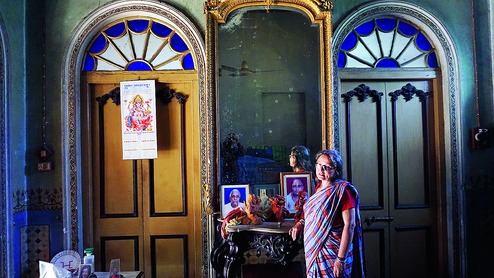Prasun Chaudhuri meets the gentle spirit rallying for Chandernagore’s endangered heritage

Picture Credit: Prasun Chaudhuri
The 24-year-old Belgian scientist arrived in Calcutta one autumn 30 years ago. She was part of a Unesco delegation that was visiting India to raise awareness about the HIV virus in these parts. Like the rest of her colleagues, Neline Colassin was suitably qualified. She had a triple Master’s in Physiology, Cellular Biology and Biochemistry.
In her spare time, she wanted to explore her new habitat. Someone told her about the erstwhile French colony of Chandernagore, 50 kilometres from Calcutta. Neline remembers listening with rapt attention about the small Bengal town and its famed Jagaddhatri Puja. The spectacular fireworks that were part of the celebratory experience and how the tradition possibly owed itself to French administrators who would organise something similar to celebrate the Fall of the Bastille every year.
Neline, who had spent several years at École Normale Supérieure – a school of science in Paris – was fascinated, and one weekend, she decided to see for herself what Chandernagore was all about.
She was referred to a local, a certain Ujjal Mondal, who was involved in another Unesco project – something to do with the restoration of the French institute there. Reminisces Neline, “I did meet that certain Ujjal Mondal and have been meeting him every day ever since.”
In love stories, things have a pace of their own. There is no too soon or too late. Before a year was up, Neline and Ujjal were married.
Neline came to live in the Mondal Mansion, a 277-year-old family house of French colonial-style architecture on the banks of the Ganges, which had definitely seen better days. Says Neline, “Though I had been a scientist, my marriage into the Mondal family turned me into a heritage conservationist.”
As Neline explored the locale, she discovered how French architectural styles had mingled with indigenous ones. “There’s a confluence of French and Bengali styles in architecture, furniture and town-planning. You can see a similar blend of Tamil and French styles in Pondicherry,” she says in mellifluous Bengali with French top notes.
Most houses from that time retain a basic Indian plan – a courtyard in the centre and rooms built around it. The foreign influence is apparent in the facades, intricate stucco detailing – a fine plaster – decorative cast iron grilles, crafted murals and gargoyles. The Mondal Mansion is no exception.
The Mondals, we are told, were essentially traders dealing in salt, swords, wine and foodgrains, among other things. But they seem to have made most of their money from escorting merchant ships in the high seas. “The family had a small private army that fought Portuguese pirates in the Hooghly with expertise. In fact, the pirates were forced to sign a deal that they’d never attack a ship that carried this family’s flag. Thereafter, the Mondals would escort ships of other traders for a fee,” Neline explains.
According to the Mondals, their ancestors ranked among the 20 richest families of India in the late 18th century. The house itself was built in 1741. It took 10 years to complete all 85 rooms. In time, of course, a large part of the house was swallowed by the elements – earthquakes, floods and the changing course of the Hooghly.
Neline, who very graciously takes The Telegraph on a walk-through of the Mondal Mansion, points out the ornate staircase made of Burma teak, the colonnade, the grand Belgian mirror, centuries-old wine bottles and frescoes on the walls. “You’ll find the same frescoes in Napoleon Bonaparte’s house in Paris,” says Ujjal.
The ballroom is said to have hosted performances by Antony Firingi, the poet-singer of Portuguese origin, famed for his devotional songs to Kali. “He was a manager at the salt godown owned by my forefathers,” claims Ujjal. He has been told that Antony was encouraged notwithstanding the disapproval of the locals – they didn’t want a Christian to sing songs in praise of a Hindu deity. Adds Neline, “They [the Mondals] were liberals influenced by the French. Unlike the British, French colonialists were much more open-minded and loved the fusion of the two cultures.”
Despite the crumbling heritage around them, or probably because of it, Neline and Ujjal have become passionate members of The Heritage & People of Chandernagore, a heritage conservation project in association with the Embassy of France in India. Says Neline, “The unique cultural and architectural heritage is being systematically decimated here. Every other week you’ll find a structure demolished. Recently, a century-old printing press was razed.” And then there are all those real estate sharks casting their long shadows. “Several structures have disappeared but we can save the remaining few with a concerted effort,” says Neline.
The Mondal Mansion has managed to survive so far. On a moonlit night, while walking on the expansive terrace, Neline says she feels excited to be the inhabitant of such a grand old place: “The old walls talk to me. They tell me their stories.”
source: http://www.telegraphindia.com / The Telegraph,Calcutta,India / Home> West Bengal / by Prasun Chaudhri / March 25th, 2018